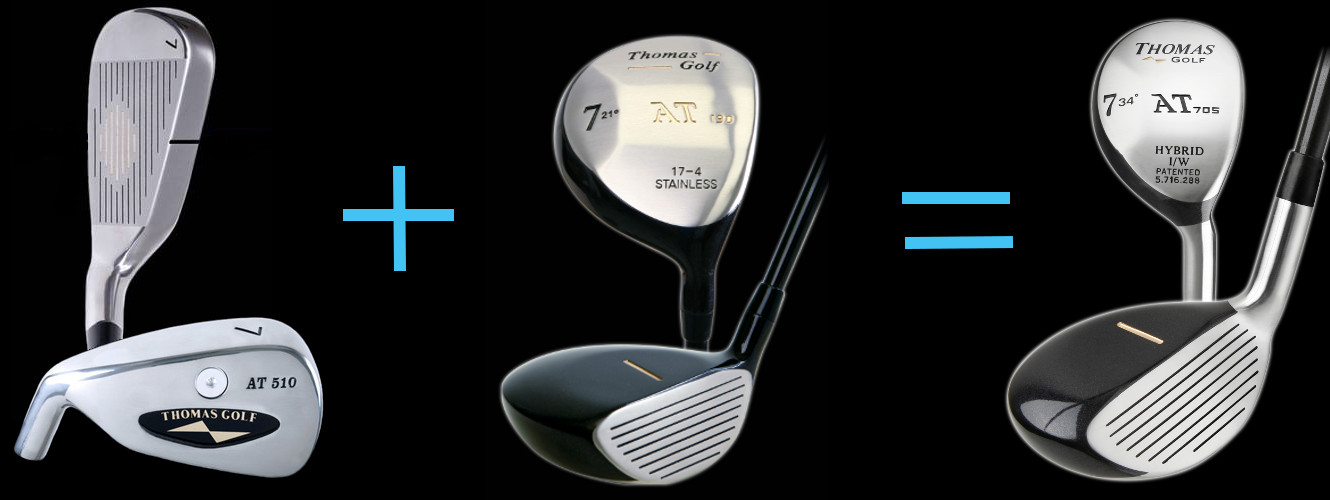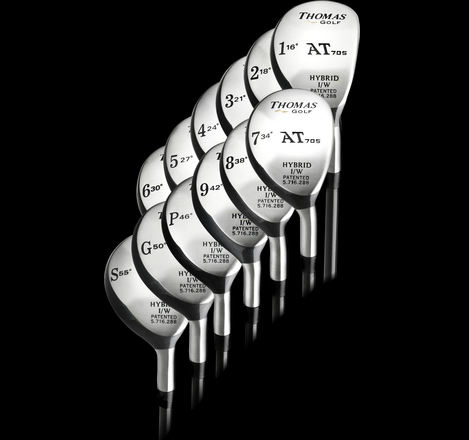Hybrid, rescue and utility golf clubs have become very popular replacements for standard irons that are less forgiving when used by the everyday golfer. Touring pros are also carrying hybrids, mostly to replace long irons like the 1, 2, and 3.
The terms hybrid, rescue and utility refer to the same type of golf club. Hybrid golf clubs get their name from a design that includes attributes of both standard irons and fairway woods. This combination creates a golf club that is more forgiving on off-center contact; is easier to hit high, giving the ball a softer landing on the green; and is ideal for a sweeping swing rather than a downward blow that takes a divot.
Most amateur golfers and some pros could not hit 1- and 2-irons consistently, but achieve very good results when switching to hybrids with the same lofts.
When you hit a hybrid golf club, you'll discover the ball will travel about the same distance as a standard iron when hit dead center, but will go much farther on heel or toe contact.
New golf clubs don't come on the market very often.

Sure, new models come on the market all the time, as golf club manufacturers are always trying to tempt players into purchasing the latest and greatest gear available. But entirely new categories of clubs? Those are rare, to say the least. In recent history, the category of hybrid clubs is the only one which has made a lasting impression on the game as a whole.
Not long ago, hybrid clubs were a niche market, produced and used by a relative few. However, hybrids have steadily been gaining in popularity, and today they are accepted as a common sight on the range and the course. Even if you don't personally own a hybrid club just yet, you almost certainly have seen one in action. Your friends probably have some hybrids, and you've seen professional golfers on TV use them as well. Their popularity is impossible to ignore at this point, and you've probably been thinking about adding one to your set.
In this article, we are going to discuss the hybrid club from a variety of angles. What does this type of club have to offer the average golfer? Why have these clubs become so popular? If you are a serious golfer, you certainly don't want to waste any of the 14 available spots in your bag. If a club isn't going to be effective, you don't want to put it in your bag. By the end of this article, we think you'll agree that hybrid clubs are very much worthy of holding a spot in your bag. In fact, you may wind up with more than one as part of your set when all is said and done.
All of the content below is based on a right-handed golfer. If you happen to play left-handed, please take a moment to reverse the directions as necessary.
The Basic Concept

There is no such thing as a perfect golf club. With every club you consider putting into your bag, there are going to be pros and cons to consider. Sure, some clubs will work better than others, but none of them will be a completely perfect solution. You are always going to have to sacrifice something in order to gain something else. That's just how this game works.
The idea behind hybrid clubs is to limit the downsides by drawing from two existing golf club categories. We aren't saying that hybrid clubs are perfect – they aren't – but they do an excellent job of blending performance characteristics from two categories which previously existed independent of one another. Those two categories are fairway woods and long irons. Rather than having to choose one or the other, you can opt for a hybrid. As the name suggests, these clubs are a 'hybrid' of those two types of clubs, meaning you can benefit from some of the strongest traits of each.
Let's take a quick look at some of the strong points that hybrid clubs take from fairway woods and long irons.
- Forgiveness of fairway woods. This is the big one. Since hybrids have a hollow-head design, like a fairway wood, they tend to be much easier to hit than traditional long irons. Shots which are not struck perfectly on the sweet spot can still turn out okay, which is not something that can usually be said when a long iron is used. Many amateur golfers turn away from using long irons because they are so punishing, which is why hybrids have become such a popular alternative. Without such a harsh feel at impact, and without such a significant penalty for missing the sweet spot, amateur players tend to feel far more confident when they look down at address and see a hybrid sitting behind the ball.
- Thin profile like a long iron. Okay, so most hybrid clubs are thicker than long irons, but they still have a relatively thin profile. The back of the clubhead does not extend as far away from the face as it does on a fairway wood, which offers so notable performance advantages. Specifically, hybrid clubs tend to do a much better job of dealing with poor lies than the average fairway wood. If you are playing a shot where the ball is sitting down slightly in some short round, you may be able to handle the shot with a hybrid. It's tough to hit this shot with a fairway wood, since the wide sole will glide across the top of the rough instead of digging down to get to the ball.
- Fairway wood-like distance. One of the obvious reasons that hybrid clubs have become so popular is the simple fact that they are capable of producing impressive distance. When struck cleanly, a hybrid will almost always offer more distance than a similarly-lofted long iron. In addition, hybrids tend to fly higher than long irons, so you can bring the ball in softer when it (hopefully) lands on the green. This combination of plenty of distance and impressive height are a big part of what make hybrids so useful to such a large group of players.
- Variety like using an iron. Finally, you are likely to enjoy the fact that you can produce a few different kinds of shots with a hybrid – much in the same way that a skilled player can produce variety with a long iron. Only, in this case, you don't need quite as much skill to hit those shots. For instance, if you need to keep the ball down out of the wind, it should be easier to hit a punch shot with a hybrid than it would be with a fairway wood. You'll get some nice forgiveness, but the ball will still fly relatively low (when the shot is executed correctly, of course). With only 14 spots available in your bag to work with, it is important to get as many different kinds of shots out of each available slot. Using a hybrid or two is going to help you add versatility to your game.
Hybrid clubs earned their name. They really are a nice blend of the best characteristics offered by long irons and fairway woods. While they might not be perfect, there isn't too much to complain about with this category of golf club. And, of course, the popularity speaks for itself – there is obviously a lot to like about hybrids, as countless golfers have decided to add this type of club to their bag in recent years.
Why Carry a Hybrid Club?

Already, you should have a pretty clear picture of what it is that makes hybrid clubs so useful. But are they right for you? That's the question we are going to tackle in this section. You need to be sure that your game stands to benefit from picking up one of these clubs, and you also need to know which old club you are going to take out of your set. We are going to walk through some points that will help set your thinking straight.
- You have trouble with your long irons. This is a common reason for a golfer to seek out the help of a hybrid. For example, let's say that you currently carry a three iron in your bag. Are you able to hit that three iron effectively on a consistent basis? If the answer is no, then it probably doesn't make much sense to keep that club in your bag. Again, you only have room for 14 clubs, so it is a mistake to keep one that you really don't feel comfortable using. If you can replace a poorly performing long iron with a reliable hybrid, you will have upgraded the overall status of your set.
- You need to hit your long shots higher. We already mentioned how hybrids can be helpful in terms of hitting higher shots. If you have particular trouble hitting your long shots high in the air, a hybrid is a smart pick. Suddenly, you will have the capability to hit long shots that actually come to a stop when they land on the green, rather than running off the other side. This is a particularly important step in the right direction for golfers who live and play in a dry environment. If your local courses tend to feature firm turf, hitting your long shots a bit higher in the air can have a profound effect on your scores.
- You like to hit other clubs off the tee. Most amateur golfers hit the majority of their tee shots with a driver, but you don't have to follow that trend. In fact, you may be better served by using less club off the tee in some situations, especially if you are playing a narrow course with plenty of hazards. Since hybrid clubs are a great option for tee shots on short par fours, having one or two of them available will add versatility to your game.
- You want to conquer some long par threes. Does your favorite course feature at least a couple long par threes? If so, you may struggle to find the right club to use off the tee on these holes. Since long par threes are among the most difficult holes in golf, your performance on these holes will go a long way toward determining your score for the day. By picking out a hybrid or two which can hit shots in the right range to deal with these long par threes, you'll suddenly have a good option to attack the green on these challenging holes.
There are four points included in the list above, but this is just a start. Once you add a hybrid or two to your set, you'll almost certainly find that there are even more benefits to be enjoyed. A hybrid is the kind of club that you'll come to appreciate more and more the longer you have it in your bag. It may be used mostly for one kind of shot at the start, but as you gain experience you will continue to find more ways to press these clubs into action.





